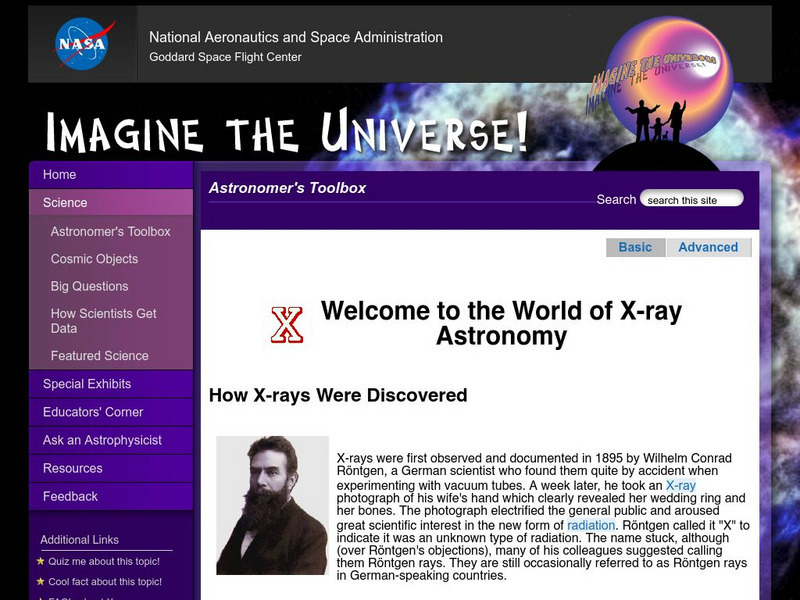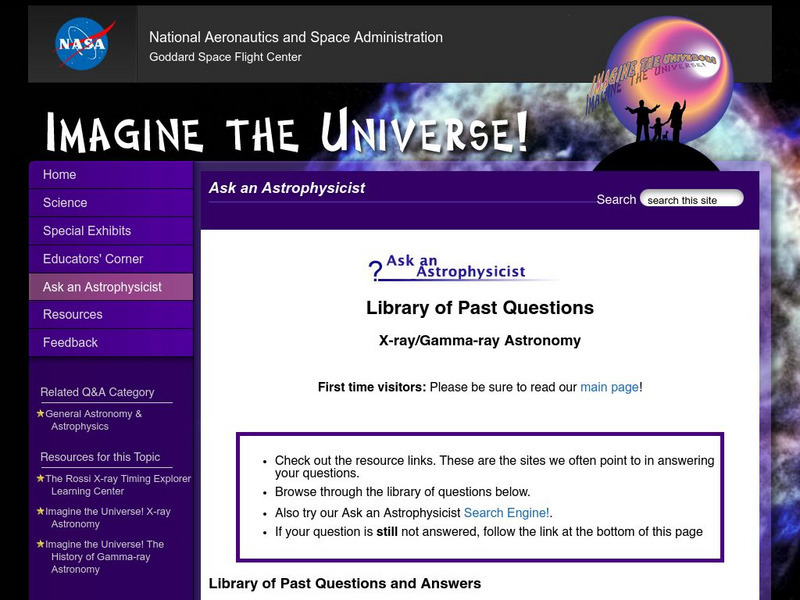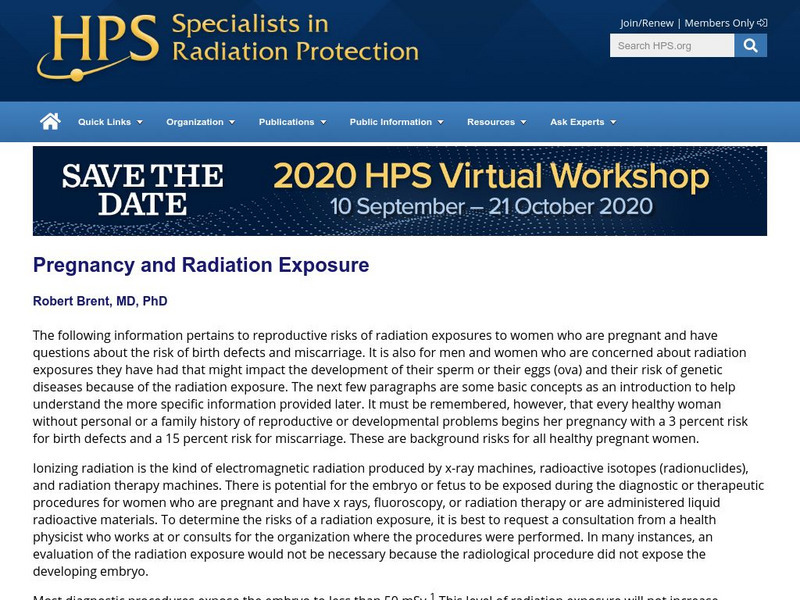TED Talks
Ted: Ted Ed: How X Rays See Through Your Skin
Learn how x-rays were discovered, and how x-ray machines and CT scanners are able to see inside the human body. Includes a video, multiple-choice and open-ended questions, background information with links for further research, and a...
NASA
Nasa: Imagine the Universe: Welcome to the World of X Ray Astronomy
Site recounts how X-rays were discovered as well as who discovered them. Offers graphics, links to facts on this topic, a quiz, and teacher resources.
Harvard University
Smithsonian Astrophysical: Chandra X Ray Observatory
Chandra X-Ray Observatory is an space observatory designed to detect x-rays. The public web site gives information about Chandra and X-ray astronomy in general (in field guide). It also gives educational materials for teachers.
TED Talks
Ted: Ted Ed: Mysteries of Vernacular: X Ray
The story of the word X-Ray is one of great thinkers. French philosopher Rene Descartes isolated the letters X, Y and Z to stand for unknowns, and centuries later, Wilhelm Rontgen discovered the X-ray, using the X for the unknown nature...
A-Z Animals
A Z Animals: Animal Facts: X Ray Tetra (Pristella Maxillaris)
This entry identifies the defining characteristics of the pristella maxillaris, otherwise known as the x-ray tetra.
Symmetry Magazine
Symmetry Magazine: Explain It in 60 Seconds: X Ray Lasers
X-ray lasers are produced by electron beams and are extremely intense,. They have important applications in particle physics. "Explain It In 60 Seconds" is an article series that aims to summarize in a few paragraphs the meaning of...
NASA
Nasa: Imagine the Universe: X Ray, Gamma Ray Astronomy
Frequently asked questions are answered about gamma rays.
Massachusetts Institute of Technology
Mit: Invention of the Week: William D. Coolidge: The X Ray Tube
Read about William D. Coolidge, his education, work, and his invention--the X-Ray Tube--as well as other medical innovations he is credited with. Learn how x-rays work and how they have contributed to the medical world.
Harvard University
Harvard Univ.: Chandra X Ray Observatory Center
The Chandra Observatory uses x-ray telescopes to learn more about the make-up of the universe. To learn more about x-ray telescopes and to see what they reveal, click here for the official Chandra X-ray Observatory website.
Harvard University
Chandra X Ray Observatory Center: X Ray Pulsar
X-ray pulsars are explained. Features a Java applet that simulates a pulsar and allows the viewer to control the rotational speed.
Concord Consortium
Concord Consortium: Molecular Workbench:an Introduction to X Ray Crystallography
Investigate how we can learn about molecular structure using x-ray crystallography in this module.
University of Colorado
University of Colorado: Physics 2000: X Rays
Here's a really simple demonstration of a fluoroscope. There are links to more information about the uses of X-rays as well.
Science Museum of Minnesota
Science Museum of Minnesota: Lessons: X Rays
Lesson that teaches about X-rays and how they are used in diagnosing ailments of the heart and lungs.
Nobel Media AB
The Nobel Prize: Arthur Holly Compton Biographical
In addition to overviewing Compton's (1892-1962 CE) studies in x-rays, this article includes information on Compton's published works, his education, and personal life.
University of Colorado
University of Colorado: Physics 2000: Cat Scans: Projecting Shadows
This page and the three pages which follow discuss how X-ray technology can be used to produce an image of the human body. Discussion is understandable and highly intriguing. Several interactive animations allow the visitor to explore...
NASA
Nasa: Imagine the Universe: The History of Gamma Ray Astronomy
This NASA article discusses the history of gamma-ray astronomy. Related resources.
Harvard University
Chandra X Ray Observatory: Video Podcasts: The Incredible Two Inch Universe
A set of podcasts outlining a four-step process for understanding the vastness of our universe, from the vicinity of the Earth and Moon, out into distant galaxies. Downloadable instructions and a handout are included, as well as...
NASA
Nasa Star Child: Chandra X Ray Observatory (Level 2)
A description of the missions of Chandra. There is also an audio song. Glossary, graphics and printable version of page included.
National Inventors Hall of Fame
National Inventors Hall of Fame: William D. Coolidge: Vacuum Tube (X Ray)
This site provides a brief biography on William D. Coolidge, inventor of the X-ray tube, also known as the "Coolidge tube."
Lawrence Berkeley National Laboratory
Berkeley Lab: The E Xperiment Files
Discussion of the scientific method and the use of X-ray microscopy as an experimental technique. Explains the use of X-ray microscopy in the study of malaria.
Other
Translating Virtual Reality Into Physical Reality
A fascinating site which demonstrates the application of X-ray technology and other medical imaging techniques. Site explores how CT scans can be used to create models of the human body. Several pages with incredible graphics and...
NASA
Viewing the Violent Universe: What Are Gamma Rays?
The universe produces a broad range of light, only a fraction of which is visible to our eyes. Gamma rays are nonvisible light, which also includes x-rays, ultraviolet light, infrared radiation, and radio waves.
Nobel Media AB
The Nobel Prize: Arthur Compton Nobel Lecture: X Rays as a Branch of Optics
This site from the Nobel eMuseum provides great information on Arthur Holly Compton. The information is provided by links, ranging from a biography to the presentation speech, along with the nobel lecture and other resources.
Other popular searches
- Animal X Rays Preschool
- Animal X Rays
- X Rays Mri Bones
- Preschool Lessons X Rays
- X Rays Art Preschool
- Understanding X Rays
- Bones and X Rays
- X Rays and Scans
- X Rays Preschool
- X Rays Tech
- X Rays Tech Schools
- Radiation and X Rays














